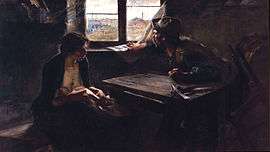Baring crisis

The Baring crisis[1] or the Panic of 1890 was an acute recession. Although less serious than other panics of the era, still it is the nineteenth century’s most famous sovereign debt crisis.[2]
Background
The crisis was precipitated by the near insolvency of Barings Bank in London. Barings, led by Edward Baring, 1st Baron Revelstoke, faced bankruptcy in November 1890 due mainly to excessive risk-taking on poor investments in Argentina. Argentina itself suffered severely in the recession of 1890 with its real GDP falling by 11 percent between 1890 and 1891,[3] An international consortium assembled by William Lidderdale, governor of the Bank of England, including Rothschilds and most of the other major London banks, created a fund to guarantee Barings' debts, thereby averting a larger depression. Nathan Rothschild remarked that if this had not happened, perhaps the entire private banking system of London would have collapsed which would have caused an economic catastrophe.
The international financial distrust generated with this crisis helped to blow a bubble in the Brazilian economy, which had been inflating since the previous decade, anticipating both its expected end, as the financial crisis that followed on that country, which in turn along with Argentine and Uruguayan crisis, dramatically decreased the amount of money sent by European immigrants to their countries of origin, also affecting the economy overseas in the 1890s.[4]
See also
- The historical novel Stone's Fall by Iain Pears. The Panic of 1890 is part of the historical setting and many historical persons appear as characters, although the novel's invention of secret conspiratorial events leading up to the crisis is fictional
- An episode of the BBC drama series, Ripper Street,[5] is set against the backdrop of the crisis.
References
- ↑ the Baring crisis of 1890 : The New Palgrave Dictionary of Economics
- ↑ Kris James Mitchener (September 2006). "The Baring Crisis and the Great Latin American Meltdown of the 1890s" (PDF). Santa Clara University and NBER. Retrieved 26 February 2012.
- ↑ Kris James Mitchener & Marc D. Weidenmier: The Baring Crisis and the Great Latin American Meltdown of the 1890s, NBER, 2007.
- ↑ "Latin American Economic Outlook 2010" OECD 2009 Part I, page 36
- ↑ "Threads of Silk and Gold". Retrieved 7 October 2014.
Further reading
- Glasner, David and Thomas F. Cooley (1997). Business Cycles and Depressions: An Encyclopedia. Garland Pub. pp. 50–51.
- Ziegler, Philip. The Sixth Great Power: A History of One of the Greatest of All Banking Families, the House of Barings, 1762-1929. Illustrated. 430 pp. New York: Alfred A. Knopf.